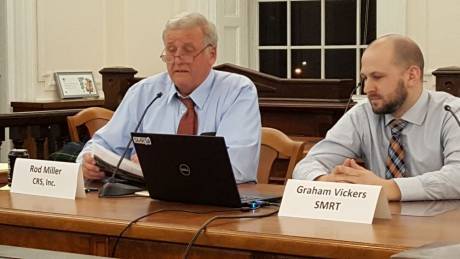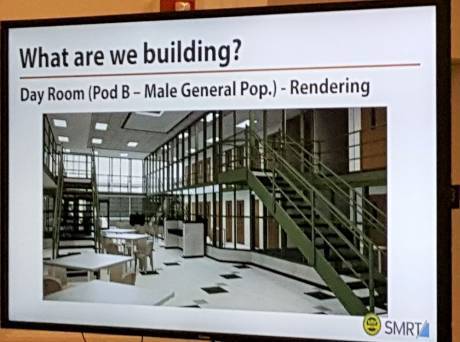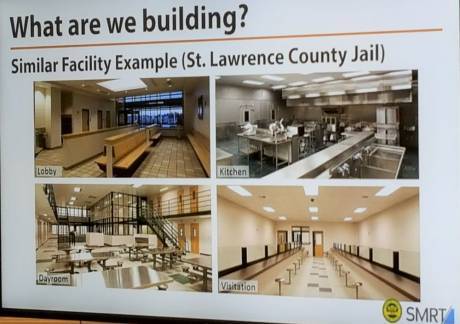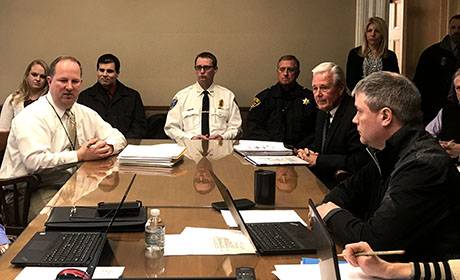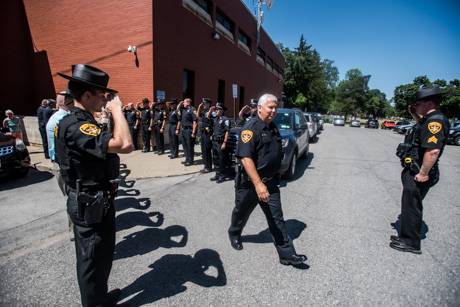Genesee officials energized by the possibility of a shared jail with Orleans County
A partnership with Orleans County may be the key that unlocks the door leading to the construction of a new $60 million Genesee County Jail to be located just east of County Building 2 on West Main Street Road.
“Here’s an opportunity for an efficient, 21st century, state-of-the-art jail that is ready to go. We have the designs … we have willing partners to the north and in Genesee County, so we hope that it is something he (Gov. Andrew Cuomo) is willing to get behind.”
Those were the words of Assistant County Manager Matt Landers, reporting on the progress – or lack thereof due to the coronavirus – of the proposed 184-bed jail during a Genesee County Legislature “Committee of the Whole” meeting Monday via Zoom videoconferencing.
Landers said he is hopeful that state laws prohibiting a shared jail could be alleviated and that Cuomo would see the benefit of such an arrangement – one that lines up with the governor’s call to reinvent the way local government operates.
“(Cuomo) had in his budget some easing of the laws, restrictions that made it difficult to have any kind of coordination with jails in the state, but that didn’t make it to the final budget,” Landers explained. “Seeing that there are talks of a potential (federal) stimulus 4 package out there that may have a large infrastructure component to it, this could be something that could be attractive.
“It meets a lot of the benchmarks .. that you’d think the governor would be interested in. It is something that he is continually harping on – reimagining New York and how we do business.”
Along with looking at new ways to facilitate services in line with Albany’s wishes, the meeting focused on five other pertinent areas:
-- Shared jail housing opportunity;
-- Maintenance of the current jail;
-- Cost of boarding out inmates if current jail was closed;
-- Status of activity on new jail:
-- Impact of bail reform, social justice on jail population.
SHARED JAIL HOUSING OPPORTUNITY
According to Landers, who is cochairing the jail steering committee with County Sheriff William Sheron, officials from Orleans County are willing to team with Genesee to explore the possibility of a joint facility.
“Building a new jail with the opportunity to do that with a partner up north – that’s where we’re focusing our energy and efforts right now,” he said. “It’s going to rely heavily what Albany allows and what kind of funding comes out of stimulus 4 on the infrastructure side and what kind of funding comes out of Albany.”
A shared jail could lead to increased efficiency in the delivery of services, with technology likely to stay in play, Landers said, noting the current use of Skype and other video and teleconferencing software.
County Public Defender Jerry Ader said he foresees legislation to allow for a greater use of electronics for proceedings, but “it may take a while and it may not be as much of a cost-savings as we’re led to believe.”
“Right now, our jail is across the street and other than maybe bringing an inmate from the prison, which is a state cost, or if we have female inmates in jails outside the county, which might be some savings, I don’t think you’re going to get the savings you’re expecting just on electronics … that’s just my opinion,” he said.
Landers mentioned that with a new jail, “there’s probably less opportunity for that (type of) savings because it’s not going to be that difficult to transport people from the jail right here in Batavia (compared to having to transport from other parts of the state as has been the case).”
MAINTENANCE OF THE CURRENT JAIL
Highway Superintendent Tim Hens said the county will be unable to avoid ongoing expenses (repairs and renovations connected to safety and mandated services) to keep the current jail in the City of Batavia going for, what could be, another three to five years.
In a discussion with the Public Service Committee last month, Hens said that $3.5 million worth of projects at the 40-year-old jail are on the punch list for the next five years if the county is forced to hold off on the new jail.
Concerning the new jail, Hens said to expect a 30-percent increase – or $50,000 -- in his facility maintenance budget to run a facility of that size, and a similar percentage add-on as the cost of doing business in New York State.
COST OF BOARDING OUT INMATES
Sheron said that the state Commission on Corrections recognizes that the county is in a “pause period” and has not indicated it would shut down the current jail.
But in case that did happen, the going rate to house out inmates is $100 per inmate, Landers said.
“It would be sizeable cost on an annual basis if we were forced to do this, if we had a population of 50 or more, but at the same time there would be the opposite cost of running a jail that would help offset that cost,” Landers said.
The assistant county manager noted the good working relationship among the COC, sheriff’s department and the architects and engineers involved with the project, so, “we would have significant lead time if there’s anything brewing that we need to be concerned about to start planning for.”
STATUS OF ACTIVITIES ON NEW JAIL
As indicated, the new jail project is in a holding pattern, but the county has closed on the land acquisition, and the schematic designs of the jail are complete, Landers said.
He said the county has two contracts in force – one with SMRT, the design firm, for about $2.3 million and one with Pike Company Inc., the construction manager, for around $1 million.
Both SMRT and Pike are aware of the county’s plight and “looking forward to getting back to work on this project, just as we are,” Landers said.
To date, the county has spent more than $1 million on the contracts, which are being funded by established jail reserves built up by proceeds of the former county nursing home sale and higher than expected sales tax receipts in 2018, Landers reported.
“We have reserves of about four to five million dollars (the number is around $8 million when considering the jail reserve fund) that are going to be used in the short term to fund these contracts until we get long-term debt financing,” he said. “Once the long-term debt financing comes in, it will cover these contracts and replenish that reserve. So, we need that full reserve to help get through what we are calling the Delta period.”
Landers said that the financing plan has been “blown out of the water by COVID-19” since it was expected to use an increase in sales tax proceeds starting in 2020 to fund the debt service payment on the new jail.
IMPACT OF BAIL REFORM ON POPULATION
Landers said recent changes to the original bail reform laws could result in an increase in jail population, but it’s too early to tell how much as courts remained closed.
Jail Superintendent William Zipfel reported that approximately 90 sentencings have been put off, and predicted that 30 to 45 percent of those people may receive jail time.
“The issue with that is, from district court, they won’t be doing sentencing for in-custody people until sometime in July, but they are starting to sentence people who are not in custody – and won’t have jail time built up,” he said. “I’m guessing our population sometime before this fall is going to come back up that 50 or so level at least.”
Landers said the county jail population in July 2019 was at the level we expected to be at in 2042,” he said. “Going back a year ago, there were concerns that we were building a jail that would be too small because our sizing had grown to what we were projecting in 2042.”
Today, the jail population is at 36, including one female who is housed in Wyoming County.
“This significant volatility is just another reason why -- until we have a clearer picture -- that we’re taking a pause in the timing,” he said.




